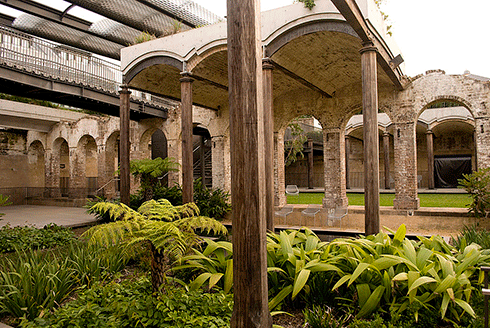
|
Published: 21 October 2013
A walk through the parks of the future
Author Amalie Wright talks to ECOS about her book Future Park: Imagining Tomorrow’s Urban Parks – a journey through unconventional park spaces in cemeteries and sewage treatment plants, on disused railway lines, among the ruins of industrialised zones, and in abandoned urban spaces.

|
|
Paddington Reservoir Gardens, Sydney: before its rebirth as a park, the reservoir was a deteriorating underground fuel storage tank for a service station. Credit:
Twistie.man
|
Amalie Wright challenges the popular understanding of parks as highly structured, professionally designed places that give users access to nature in sanctioned ways.
Instead, she celebrates parks – and park users – that break the rules. Sustainability is at the heart of the parks featured in her book. These parks reclaim neglected and unused land, and include large-scale regional greenings. They are attempts to not only repair damaged landscapes, but also to strengthen fragile communities buffeted by rapid social change.
Among the parks you discuss are those showcasing wastewater treatment plants, including the biggest sewage treatment plant in New York City, Newtown Waste Water Treatment Plant. What interests you about this type of infrastructure?
On the road into the town where I grew up there was a water treatment plant. A well-maintained, little building faced the main road, and water sprayers shot water into a grove of pine trees.
It was more than just a piece of useful infrastructure – it had landscape amenity and a sense of civic pride about it. You would have no hesitation walking past it every day on your way to school or work.
So, I guess I’ve grown up thinking these kinds of parks are possible. It’s been exciting for me to see how many examples there are around the world where people have embraced that as well.
The way services are delivered to us these days, you don’t see the workings. It sort of magically appears. We find it in Brisbane – when a new tunnel or a new bridge opens, thousands of people will turn up to see it.
When the vast underground reservoir was under construction in Seattle, every time they had an open day, people flocked to it. New York’s Newtown Creek wastewater treatment plant, with its big silver digester eggs, is open a couple of times a year and queues of people form to see it.
What implications does this have for how we might design new infrastructure?
I think what’s key about some of these popular sites is that they’re designed to be visible. We should think about the possibility of public interest up front and incorporate that into design.
Let’s say you build a sewerage plant in one spot, doing it on the cheap and nasty, and then spend a lot of money screening it and building a park elsewhere. The alternative is to design it for integrating uses straight off. Then, it becomes something to be proud of, rather than something to hide.
In your book, you talk about ‘linkage’ parks along existing corridors, such as rivers and rail lines. This seems to mirror the idea of ‘biolinks’ in landscape conservation – linking patches of quality remnant vegetation. Can you comment on this?
At the most basic level, linkage parks allow access to and between places. But then, like all other parks, they have other advantages from an environmental and economic point of view.
Linkage parks can provide habitat, but unless they get to a particular size, it will be a very limited form of habitat. In fact, they often provide accidental habitat or an accidental corridor. The High Line in New York is a small-scale example of this. When it was an abandoned railway line, it had an amazing spontaneous landscape that had grown up over several decades as a result of birds dropping seeds that germinated. Many species that originally grew on the High Line's disused rail bed have been incorporated into the landscaping of the new park.
You talk about rail trails in Australia, particularly in Victoria, and caution against them becoming ends in themselves.
I applaud rail trails. Anything that can repurpose something and upcycle it to a new use is a great idea.
But we suffer from the tyranny of distance in Australia. Everything here is a long way from everything else. A lot of the infrastructure corridors that have closed down and are therefore available for repurposing are not used anymore, because they’re too remote from centres.
If there’s opportunities to keep exploiting and exploring those, that’s great. But, we should also look at opportunities to exploit linkages to other transport networks, to places where people live, to schools, to employment hubs and the things that communities need.
That’s definitely what they’re trying to do in Atlanta with the Beltline project. This exploits a network of rail that goes right around the centre of the city. As well as providing amazing parkland that will link some of the biggest and most established parks in that city, the corridor is so vast it will enable provision of light rail, and development of denser employment and education nodes that link around the city.
If you can link more activities and nodes together, effectively you get more bang for your buck – more people benefit from the investment.
Amalie Wright was in conversation with Michele Sabto. You can order your copy of Amalie’s book through CSIRO Publishing.



